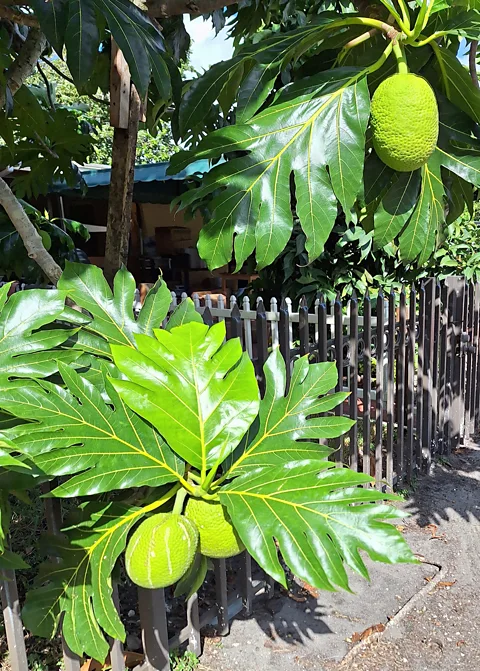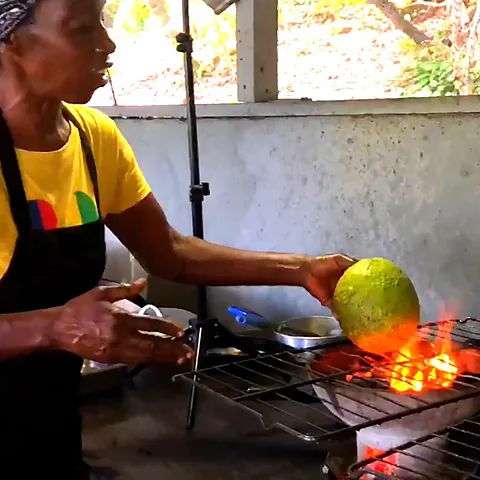Breadfruit: The Caribbean's hurricane-resistant food
 Mike Goldwater/Alamy
Mike Goldwater/AlamyWith an increase in extreme weather, Jamaicans have found a reliable, local food source in nutrient-dense and versatile breadfruit.
The humid Jamaican air smelled sweet from ripe mango and passionfruit trees. Smoke swirled around from the open fire, where a whole green knobby breadfruit sat roasting next to a pot simmering with rundown – a savoury stew made from coconut milk, tomatoes, spices and mackerel. A nearby table displayed a tray of roasted breadfruit wedges and bright red snapper, alongside cakes and rolls made with flour from the breadfruit tree. The food was prepared for an international group of botanists, visiting north-eastern Jamaica's Portland Parish to learn about the historical, cultural and economic importance of the breadfruit tree.
Originally brought to Jamaica from the Pacific Islands by the HMS Bounty in 1794, breadfruit was an inexpensive, nutritious food for enslaved Africans labouring on British-owned sugar plantations. The trees grow quickly and fruit within a year of planting, producing 200 to 400 fruits per year the size of a large grapefruit or small watermelon. Breadfruit contains all nine essential amino acids and is a good source of fibre, protein and several minerals and vitamins.
In the centuries since their introduction, breadfruit trees were abundant across Jamaica, and the fruit has been a staple of the country's cuisine. In recent years, as communities have sought out more sustainable, local and healthy food sources – especially ones that can withstand extreme weather (a breadfruit tree that's damaged in a hurricane can regrow itself) – breadfruit has experienced renewed interest as a nutritious and versatile option, providing both health and economic benefits.
Typically eaten as a side dish and used like a vegetable, breadfruit is most often roasted, peeled and sliced. Its taste is subtly sweet, with a chewy bread-like quality (hence its name). Its soft and starchy texture is akin to a root vegetable like potato or cassava. Like those foods, it takes on the flavour of the main course with which it is served.
 Dr Ken Banks
Dr Ken BanksCaroline de Lisser is a Montego Bay-based breadfruit aficionado currently working on a cookbook of breadfruit recipes. She explained, "All Jamaicans love breadfruit, and there's practically a tree in every yard. To me, it tastes like a very soft roasted chestnut crossed with good bread."
Cynthia ("everyone calls me just Cynthia"), opened her eponymous restaurant on Winnifred Beach in Portland Parish 26 years ago and has been serving breadfruit since day one. "Breadfruit is like rice or potato, and it can be roasted, boiled or fried," she explained. "We can even make cake and drinks from it."
Cynthia has noticed an increase in the fruit's popularity in recent years. "It can be eaten with any meat and without meat," she explained. In her open-air kitchen by the beach, Cynthia roasts whole breadfruit over an open flame for about 20 minutes, until a knife slides easily through the skin. After removing it from the flame, she peels off the skin with a large knife, carves out the pit, and cuts the remaining flesh into slices. A warm, freshly roasted breadfruit slice is a tasty finger food treat. "My favourite way is to roast it and have it natural [without accompaniment]. It's very tasty, sweet, finger-licking."
 Susan B. Clark
Susan B. ClarkHowever, Cynthia usually serves the roasted breadfruit as a starchy side to other dishes. "One of our favourites dishes in Jamaica is ackee(a small, rosy fruit eaten like a vegetable) and saltfish with breadfruit," she said. "I [also] serve breadfruit with fried chicken, curry chicken, curry lobster, with rundown, fried fish, and escovitch (fried fish in vinegar)".
Breadfruit can also be processed into flour, creating a gluten-free alternative for baking.
Karlene Johnson uses the flour at her bakery outside of Kingston called Something Country. Her treats include bulla (a cake-like snack made with molasses), bammies (a flatbread originating from the island's Indigenous Taíno peoples) and oatmeal cookies. "Historically, breadfruit is important," she said. "Culturally, every Jamaican can identify it as part of their gastronomic experience. Economically, Jamaica stands to benefit from local and international sales of the raw fruit and other processed products."
Despite the abundance of breadfruit, fish and other fresh produce available on the island, most food consumed in Jamaica is imported, according to a 2022 report from the Food and Agriculture Organization of the United Nations (FAO). This has created food insecurity and price inflation; hurricanes interrupt shipping, and droughts and floods elsewhere in the world inflate prices. According to the World Meteorological Organization, the Caribbean has experienced a 25% increase in severe hurricanes since 1980, along with rising temperatures and sea levels. Additionally, according to the FAO report, much of that imported food is processed, which has led to an increase in related health issues like hypertension and diabetes.
 Cynthia's Restaurant
Cynthia's RestaurantAs the Covid pandemic disrupted supply chains worldwide, Jamaicans experienced food shortages. "Covid was a big wake up call. We don't grow enough of our own food here in Jamaica; a lot is imported," said de Lisser. "During Covid we started growing food again. And breadfruit is such a wonderful food source. To me, it's the tree of life. I love it."
Mary and Michael McLaughlin grew up in Jamaica and founded the Trees That Feed Foundation in 2018 with the mission to plant trees that feed people, create jobs and benefit the environment. Since its inception, the Foundation has donated approximately 90,000 breadfruit trees in Jamaica to thousands of farmers. "This tree is hearty, the food it produces is nutritious, and it is climate friendly," said Mary. "Breadfruit can reduce the country's dependence on expensive imported foods and lead to sustainable economic development." The Foundation's tree donations doubled during Covid, as communities sought more sustainable food sources.
As Jamaicans shift focus to more local and sustainable foods, the country's potential for economic growth has increased. Breadfruit is best for roasting when it's almost ripe, and it spoils quickly once picked. Because of its short shelf life, fresh breadfruit has not historically been a good candidate for export. However, pre-packaged roasted breadfruit eliminates a barrier for Jamaicans who do not have the space for open flame roasting or the time to roast, peel and prepare breadfruit from scratch, and it allows visitors and fans abroad to recreate their favourite breadfruit dishes at home. You can now buy breadfruit flour, chips, crackers, baking mixes and even vodka in Jamaica, across the Caribbean and online.
Because breadfruit is versatile, de Lisser has been experimenting with less traditional ways to use it. "I steam leftover roasted breadfruit and whizz it in the blender with coconut milk, cacao powder and maple syrup and make a chocolate mousse with an amazing texture," she said. "I have successfully made carrot cake, chocolate cake and fruit cake."
 Caroline de Lisser
Caroline de LisserBreadfruit carrot cake recipe
By Caroline de Lisser
Makes one 9in/23cm round layer cake
Ingredients
For the cake:
2 cups breadfruit flour
1½ tsp baking soda
1 tsp cinnamon
1½ cups sugar
1 cup chia seed gel (see Note; if you don't have chia, add 1 additional cup of coconut oil)
½ cup coconut oil
4 eggs
1 tsp vanilla extract
pinch of salt
3 cups of coarsely grated carrots (gently patted down in cup to make sure it is filled)
For the icing:
1½ cups icing sugar (confectioners' sugar)
two 8oz packs of cream cheese (450g)
finely grated zest of one orange
Method
Step 1
Preheat the oven to 175C/350F. Grease two 9in/23cm baking tins.
Step 2
Sift the flour with the baking soda and cinnamon into a bowl. In a separate bowl, combine the rest of the ingredients except the carrots. Add the flour mix to the wet ingredients and mix well. Fold in the carrots last.
Step 3
Spread the batter in the prepared tins. Bake for 30 minutes and check with a knife. The knife should come out fairly dry, but it won't be completely dry, as it is a moist cake. If not, bake for a few more minutes. (You may also use one 10-inch tin and bake for 1 hour.) Let the cakes cool completely.
Step 4
To make the icing, Sift the icing sugar into a bowl. Add the softened cream cheese and orange zest and mix well by hand or with an electric mixer.
Step 5
Spread the icing over the bottom cake layer, then set the second cake on top and finish icing the cake. Serve.
Note
To make the chia gel, add one part chia seeds to a jar, then add 7 parts water. Close and shake well. Let sit, shaking every so often; it takes about 15 minutes to form a light gel. Store in the fridge.
BBC.com's World's Table "smashes the kitchen ceiling" by changing the way the world thinks about food, through the past, present and future.
---
Join more than three million BBC Travel fans by liking us on Facebook, or follow us on Twitter and Instagram.
If you liked this story, sign up for The Essential List newsletter – a handpicked selection of features, videos and can't-miss news delivered to your inbox every Friday.
